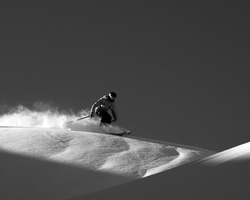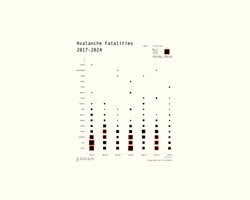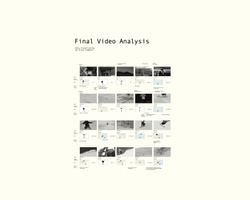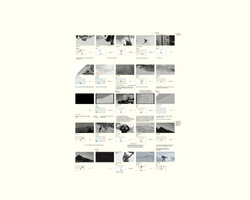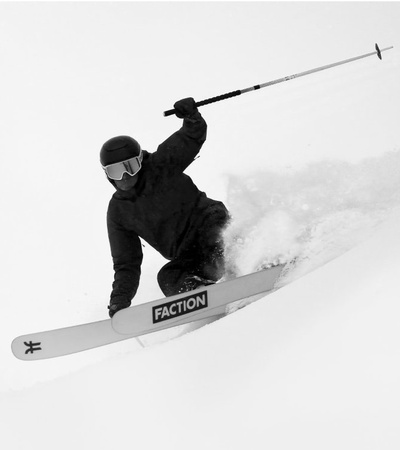
- Home
- Student Projects
- Send It?; The Interconnected Challenges Of Climate Change, Avalanche Safety And Risk-taking Behaviours Through Storytelling And Data Visualisation In Alpine Ski Environments
Send it?; The Interconnected Challenges of Climate Change, Avalanche Safety and Risk-Taking Behaviours Through Storytelling and Data Visualisation in Alpine Ski Environments
Send it?; The Interconnected Challenges of Climate Change, Avalanche Safety and Risk-Taking Behaviours Through Storytelling and Data Visualisation in Alpine Ski Environments
“The ‘human factor’ triggers 90% of deadly avalanches'' (Blunthardt, Coloradoan). This thesis is on Freeriding, a discipline within skiing that has been increasingly popular in the last few years partly due to one of the most infamous ski competitions in the world; The Freeride World Tour.
Through external and internal pressures, many experienced skiers who are well versed in off-piste skiing, mountain safety and risk assessment, are venturing into the more inclined and uncontrolled areas of the mountain to try their hand at freeriding.
However, many of these expert skiers are making poor decisions in elevated risk. Risk could be defined as the outcome probabilities being specified (Weber et al, 2009). In this case, the outcome is triggering an avalanche. Despite all warnings, skiers will take a leap of faith and play with their lives.
However, many of these expert skiers are making poor decisions in elevated risk. Risk could be defined as the outcome probabilities being specified (Weber et al, 2009). In this case, the outcome is triggering an avalanche. Despite all warnings, skiers will take a leap of faith and play with their lives.
In the last 3 seasons (2020-2023) there have been an unfaltering number of fatalities in the mountains due to avalanches, most prominently in Austria, France, Italy and Switzerland. Although high-tech avalanche gear keeps improving and developing every season, it has been used as a tool to go off-piste rather than a last resort. It is unfortunate to need to use it because that means someone is under an avalanche with only 15 minutes to spare their life. This topic has become increasingly problematic for various reasons. With the consequences of climate change and weather extremities, it has developed persistent weak layers in the snowpack, making it more prone to triggering.
Additionally, with social media’s desensitisation of ski publications, where the context is removed, as well as any prior risk assessment, and with the influx of tourism in the mountains post-covid, there has been an incredible pressure on the ski industry to come up with quick solutions and build bigger lifts in higher altitudes. With the increased accessibility to more avalanche prone terrain, fatalities are still rising. My intended audience for this thesis is the community of skiers that enjoy participating in or watching Freeride.
Through the use of data visualisation and video, the thesis aims to draw attention to the urgent need for effective communication strategies that engage viewers both intellectually and emotionally, through contextualising media and using real-life scenarios so that the community can foster a deeper understanding of the intertwined issues of decision-making dynamics and changing environments, thereby promoting responsible practices and possibly change regulations around mountain safety.
Additionally, with social media’s desensitisation of ski publications, where the context is removed, as well as any prior risk assessment, and with the influx of tourism in the mountains post-covid, there has been an incredible pressure on the ski industry to come up with quick solutions and build bigger lifts in higher altitudes. With the increased accessibility to more avalanche prone terrain, fatalities are still rising. My intended audience for this thesis is the community of skiers that enjoy participating in or watching Freeride.
Through the use of data visualisation and video, the thesis aims to draw attention to the urgent need for effective communication strategies that engage viewers both intellectually and emotionally, through contextualising media and using real-life scenarios so that the community can foster a deeper understanding of the intertwined issues of decision-making dynamics and changing environments, thereby promoting responsible practices and possibly change regulations around mountain safety.
